The advent of vascular endothelial growth factor inhibitors has initiated an explosion of research into using them for various conditions, from macular edema to retinal neovascularization, and this year's ARVO meeting has it all. Researchers have also been delving into the epidemiology of retinal disease, and have made some discoveries regarding nutrition's role. For the latest on what these physicians are finding, read on.
(Unless otherwise noted, the researchers in each abstract have no financial interest in the subject matter they're presenting.)
Battling Diabetes
Researchers at the Wilmer Eye Institute will be sharing their data regarding treating diabetic macular edema with ranibizumab. Some of the researchers receive financial support from Genentech.
In the prospective study, the physicians gave 20 patients with refractory DME intraocular injections of 0.5 mg of ranibizumab at baseline and at one, two, four and six months.
Fifteen of the patients have completed a year of follow-up. Only one patient received additional treatment, an injection of ranibizumab at month 10 due to an increase in foveal thickness of 110 µm, but with no change in acuity. The average change in acuity from baseline for the other 14 patients at one year was seven ETDRS letters, compared to nine letters at one month after the last injection at six months.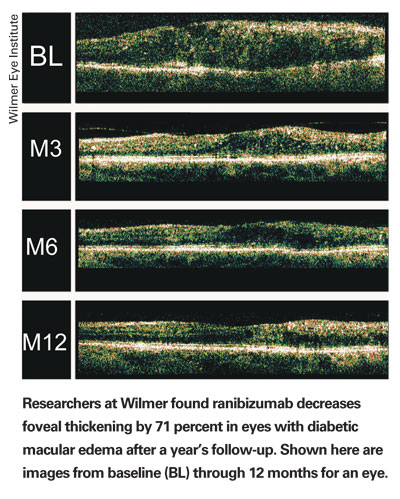
The median improvement at a year in foveal thickness and macular volume was 187 µm and 2 mm3 compared to 258 µm and 3 mm3 at one month after the last injection. Compared to baseline, median excess foveal thickness was reduced by 71 percent and excess macular volume was reduced by 52 percent.
The researchers say that, since recurrence of foveal thickening appears to precede a drop in acuity, it would be reasonable to design future trials with an initial aggressive treatment phase followed by a phase of "as-needed" treatment based upon recurrence of foveal thickening.4029
A prospective study from researchers in
Researchers recruited 63 eyes of 52 patients with focal DME from three centers, performing SRT laser on each. The SRT laser is a Q-switched frequency-doubled Nd:YLF device (527 nm) that generates pulses of 1.7 µs with a repetition rate of 100 Hz.
At six months, OCT showed a statistically significant reduction in central retinal thickness by an average of 47 µm in 35 percent of patients. Hard exudates were reduced by 32 percent and stable in 58 percent. Leakage on fluorescein was diminished or stable in 58 percent of patients. Acuity improved by more than a line or remained stable in 92.5 percent (49 eyes) at three months. At six months, 89 percent had improved or stable vision. There were no adverse events or side effects related to the laser treatment at six months.4027
Eli Lilly researchers provide an update on the drug ruboxistaurin for diabetic macular edema from their multicenter, double-masked, controlled randomized Phase III trial.
In the trial, 685 patients were randomized to receive either ruboxistaurin 32 mg/day (345 patients) or placebo (340 patients) orally and were followed for three years. Eligible patients had type 1 or type 2 diabetes, moderately severe or very severe non-proliferative diabetic retinopathy, no history of panretinal photocoagulation and best-corrected acuities of at least 45 letters (around 20/125).
The researchers say there was more frequent improvement and less frequent worsening of DME severity in treated patients vs. placebo (p=0.028), especially in eyes with clinically significant macular edema at baseline, although the abstract doesn't provide the actual results. They add that patients taking the drug had less sustained moderate visual loss (6 percent) than those taking placebo (11.5 percent; p=0.032).4026
Researchers from
In this prospective study, researchers administered 1.8 mg of bevacizumab intravitreally to 40 eyes. Thirty-three percent of them had rubeosis, 53 percent had papillary neovascularization and 65 percent had extrapapillary neovascularization.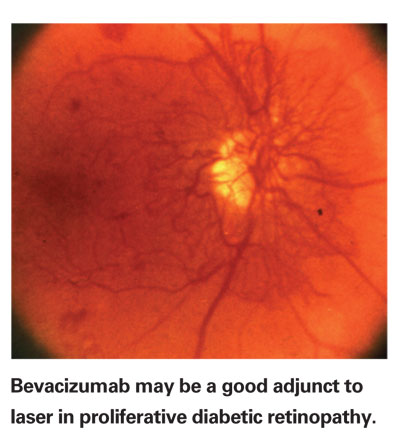
There was remission of retinal and disc neovascularization in 75 percent of the cases during the first month. In a quarter of the cases, the neovascularization persisted at one month; half had recurrence at two months and 60 percent at three months. Disc neovascularization showed better response than the retinal neovascularization. The researchers say that if bevacizumab is used as an adjunct to photocoagulation, it might reduce the overall amount of ablation needed to control the disease.1429
AMD Update
Researchers from the CLEAR-IT-2 study, sponsored by Regeneron Pharmaceuticals, will report Phase II safety, tolerability and bioactivity results of the company's intravitreal VEGF Trap in wet age-related macular degeneration patients.
In the randomized, controlled study, five groups of patients with wet age-related macular degneration were randomized in a balanced ratio to receive a series of intravitreal injections of one of three dose levels of VEGF Trap (0.5, 2 or 4 mg) into the study eye at four- or 12-week intervals over a 12-week period. They continued dosing beyond the 12th week using a criteria-based schedule.
The researchers say that there have been no serious adverse events, intraocular inflammation or serious drug-related systemic effects to date. The updated efficacy results will be presented at the meeting.4549
Researchers in
In the prospective study, researchers treated 104 patients. They administered PDT with a reduced-light dose (42 J/cm2 for 70 seconds). About 16 hours after PDT they injected 800 µm of dexamethasone and 1.5 mg of bevacizumab intravitreally. Follow-up was every six weeks. Five of the patients ended up receiving a second round of treatment due to remaining CNV. Eighteen patients (17.3 percent) received an additional bevacizumab injection.
With a mean follow-up of 40 weeks, visual acuity increased by an average of 1.8 lines (p≤0.01). The mean decrease in retinal thickness was 182 µm (p<0.01). There were no serious adverse events. The researchers will provide extended follow-up at the meeting.1829
Researchers from
In a retrospective fashion, the physicians studied 111 eyes of 111 patients at four centers. The small-lesion subgroup was composed of lesions four disc areas or smaller. The average lesion size was 3.3 disc areas, with 92 percent of them being occult. The average baseline acuity was 20/100. At last follow-up, the average change in acuity was -2.9 lines, with 41 percent of patients losing more than three lines. Fourteen percent gained more than three lines and 10 percent maintained at least 20/40 vision. Forty-three percent were switched to a different VEGF inhibitor. They received an average of 4.8 injections with an average follow-up of 31 weeks.
Sixty-six eyes of 66 patients had the small lesions, with an average loss of two lines of vision. Sixty-two percent of these eyes maintained or improved their vision, 15 percent gained more than three lines and 11 percent saw 20/40. They received an average of 4.7 injections with an average follow-up of 29 weeks.
There were a subretinal hemorrhage, a vitreous hemorrhage and a rip in the retinal pigment epithelium, as well as one systemic event, a transient ischemic attack followed by a heart attack after being switched to bevacizumab.97
Physicians from
In the retrospective study, 31 eyes received two bevacizumab injections and one PDT treatment (one week after the second injection). Sixteen eyes had complex lesions with a pigment epithelium detachment, six had CNV masked by a hemorrhage, seven had classic CNV and two had occult CNV. The mean follow-up was 6.2 months. These eyes were a sub-group of 157 eyes that were receiving bevacizumab-only injections for all types of CNV.
The researchers report that all 31 patients but one (with a pigment epithelial detachment) improved both their visual acuity and retinal thickness during treatment. After the combination treatments, 23 of the 31 patients remained stable until the end of follow-up and didn't require further treatment. Among the 126 other patients in the total group, when bevacizumab was effective, the mean number of intravitreal injections was 4.7 during the follow-up period. Among the 31 patients receiving the combined treatment, those who benefited the most were those with the most recent classic CNV.1794
Researchers from
The two-year results of the Phase III Genentech-sponsored ANCHOR study will also be presented at the meeting. ANCHOR is a randomized, multicenter, double-masked trial comparing ranibizumab 0.3 mg (Lucentis, Genentech) combined with PDT vs. ranibizumab 0.5 mg and PDT vs. PDT and a sham injection.
The researchers say that the superiority of ranibizumab to PDT was evident by one month post-treatment and increased over the 12 months. They add that some treated patients whose vision decreased at three months actually gained as many as 15 or more letters compared to baseline by a year. The two-year results weren't in the study abstract, but will be discussed at the meeting.2872
The anatomic results of ANCHOR4561 and the contrast sensitivity results4545 will also be reported at the meeting.
Also being presented at the meeting will be the six-month interim data from the VERITAS study, sponsored by Novartis and QLT. VERITAS is a prospective, randomized, double-masked, multicenter trial aimed at analyzing the safety and efficacy of combining a steroid or an anti-VEGF agent with verteporfin PDT. No data were provided in the abstract.2870
Researchers in
There were 18 eyes of 18 patients in the primary bevacizumab cohort who underwent an average of 3.4 consecutive injections. In the bevacizumab post-pegaptanib cohort, 20 eyes of 20 patients received an average of 4.2 consecutive injections of pegaptanib initially, followed by an average of 3.6 injections of bevacizumab. In both groups, 1.25 mg of bevacizumab were injected every six weeks.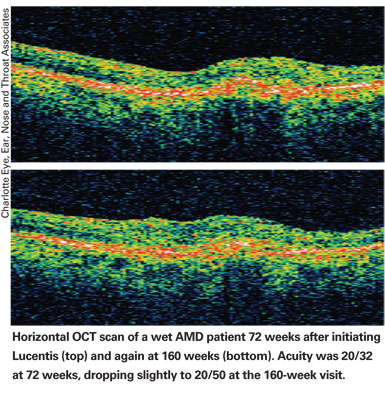
The average visual acuity improvement in the primary bevacizumab group was 1.5 ETDRS lines at three months (p=0.0009) and 3.7 lines at six months (p=0.0012) compared to 0.4 lines at three months (p=0.22) and 0.3 lines at six months (p=0.67) in the bevacizumab post-pegaptanib group. The average change in retinal thickness was greater in the primary bevacizumab eyes, 81.5 µm (p=0.0051), vs. 39.9 µm in the bevacizumab post-pegaptanib group (p=0.27).2873
Genentech researchers and a physician who consults for the company will be reporting on the results of 3.8 years of ranibizumab treatment for wet AMD.
This study is an open-label, non-controlled extension study for patients who had participated in one of three Phase I/II trials of single dose, multiple doses and escalating doses of ranibizumab. In this study, patients initially received monthly intravitreal injections of ranibizumab 0.3 mg. The researchers amended the protocol to increase the dose to 0.5 mg, and doses could be held if visual acuity and lesion characteristics were stable. Of 70 patients enrolled, 67 were treated in the extension study for up to 3.8 years. The researchers measured acuity using ETDRS charts, and the physicians will report the visual results at the meeting.
The average duration of follow-up in the extension study was 971 ±400 days for all patients (174 days for the patients from the single-dose study, 1,008 days for those from the multiple-dose study, and 968 days for the escalating-dose patients). In the 67 treated patients, the most common ocular adverse events were conjunctival hemorrhage in 20 patients (29.9 percent), retinal hemorrhage in 18 (26.9 percent), and reduced visual acuity in 13 patients (19.4 percent). The most common non-ocular adverse events were 17 cases of hypertension (25.4 percent), 17 instances of nasopharyngitis (25.4 percent) and eight cases of sinusitis (11.9 percent). On average, the researchers say that visual acuity improvement since the start of the studies was maintained.1810
The researchers in the PRospective OCT Imaging of Patients with Neovascular AMD Treated with Intra-Ocular Lucentis (PRONTO) Study will be discussing their two-year results at this year's meeting. The study is sponsored by Genentech.
Forty patients are enrolled in the study, and at the end of the first year, the average acuity improved by 9.3 letters (p<0.001). The average number of injections over that year was 5.6. The researchers say the two-year results will be presented at the meeting.1834
Partial data from a retrospective study by researchers at Bascom Palmer Eye Institute, some of whom have financial relationships with Genentech, finds that some patients who required treatment with bevacizumab responded more favorably to ranibizumab when they were switched over to the latter drug.
The researchers only have data on eight patients out of 403 who were switched from bevacizumab to ranibizumab, apparently because these eight patients weren't able to achieve a fluid-free macula for six to eight weeks while on bevacizumab. Of these patients, four achieved a fluid-free macula for at least eight weeks when switched to ranibizumab, researchers say. Improvement in central retinal thickness on optical coherence tomography was seen in five of the eight patients, with three of these patients having improvement in visual acuity and two experiencing stable vision. Three of the eight patients had similar limited responses to both ranibizumab and bevacizumab. In these patients, visual acuity and optical coherence tomography findings were stable. The researchers say data on all the patients will be available at the meeting.4534
Managing Occlusions
Researchers from Manhattan Eye and Ear Infirmary and University Politecnica delle
The researchers retrospectively compared CRVO patients seen over the course of a year with a historical gender- and age-matched group. Independent predictors of CRVO by a multivariate logistic regression model were glaucoma (odds ratio: 4.75; confidence interval: 2.33-9.71) aspirin use (OR: 2.66; CI: 1.52-4.64) and warfarin use (OR: 3.34; CI: 1.44-7.8).
The researchers say that their results imply that the vasculopathic and prothrombotic risks in some patients may not be fully addressed by antithrombotic therapy, and that the pathogenesis of CRVO may be more complicated than just the development of a primary venous thrombus.1543
A multicenter, prospective Phase II trial supported by Pfizer and OSI/ Eyetech has found that pegaptanib may be effective for macular edema due to CRVO.
The trial included 98 patients, 33 receiving 0.3 mg of pegaptanib, 33 receiving 1 mg, and 32 receiving sham injections. Physicians gave the injections every six weeks for six months, and follow-up continued for a year. Panretinal photocoagulation was permitted. 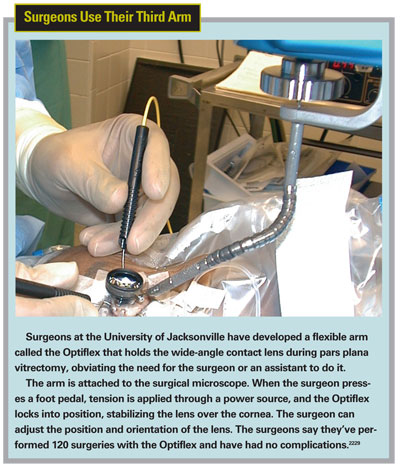
Baseline mean acuity was around 48 letters for each group. At a year, the mean change in acuity from baseline was +7.5, +6.3 and -2.4 letters in the pegaptanib 0.3 mg, 1 mg and sham groups, respectively (not statistically significant). Compared to sham, fewer subjects treated with 0.3 mg pegaptanib lost 15 or more letters from baseline to week 52 (6 percent vs. 31 percent, p<0.05), and more subjects treated with pegaptanib 0.3 mg than sham stabilized or gained acuity. Seventy percent vs. 44 percent (p<0.05) were stable, 67 percent vs. 38 percent (p<0.05) gained at least five letters.1544
Researchers at the Bascom Palmer Eye Institute, some of whom have financial relationships with Genentech, say bevacizumab can have a positive effect in patients with macular edema secondary to branch and hemiretinal vein occlusions.
In a retrospective study, the physicians reviewed the records of all patients treated for this indication over a year, comprising 30 eyes with BRVO and 11 with HRVO in 39 patients. The patients received 1.25-mg doses of bevacizumab, with retreatment occurring at monthly or longer intervals at the discretion of the physicians.
Thirty-eight eyes (93 percent) were seen at one-month follow-up, 35 (85 percent) at three months and 25 (61 percent) at six months. Mean acuity was 39 letters at baseline and 50 at six months. Eyes gained a mean of 11 letters at one month (p<0.001) and 11 letters at six months (p=0.003). Acuity increased by at least three lines in 47 percent at one month and 36 percent at six months. The mean central retinal thickness was 461 µm at baseline, 296 µm at one month (p<0.001) and 330 µm at six months (p=0.003). Acuity loss of three or more lines occurred in 3 percent of patients at one month and 4 percent at six months. Thirty-three (91 percent) eyes received more than one injection by six months of follow-up. There were no cases of uveitis, endophthalmitis, retinal detachment or systemic complications.1546
Other Studies
Austrian researchers have conducted a prospective, randomized study comparing 23-ga. sutureless, pars plana vitrectomy to standard 20-ga. surgery.
In the study, they randomized 60 patients to one of two surgery types. Indications for surgery were preretinal membrane, vitreous hemorrhage, retinal detachment, diabetic retinopathy, synchisis scintillans, macular edema and macular hole. They excluded patients with previous vitreous or retinal surgery.
The researchers say that patient comfort was significantly higher in the 23-ga. group (p<0.02), and the conjunctival injection was significantly lower (p<0.02), during the first three postoperative days. Total surgery time was almost equal (p=0.93) but unequally distributed, and vitrectomy in the 23-ga. group took significantly longer (p<0.032). Wound closure was significantly shorter in the 23-ga. group (p<0.0001). More cases showed postoperative hypotony with 23-ga. (n=6) than 20 ga. (n=2), though this wasn't statistically significant.
The surgeons say vitreous and retinal instruments showed sufficient stability, but trocars and plugs caused difficulties during 23-ga. surgery in five patients. The surgeons say that no technical difficulties occurred in the 20-ga. group. Suturing of sclerotomies and conjunctiva was necessary in four cases in the 23-ga. group, and more severe postop complications occurred in the 23-ga. patients (n=5; one eye lost due to massive choroidal hemorrhage) than in the 20-ga. group (n=3).6029
Physicians now have a new dietary subject to counsel their patients on: the glycemic index.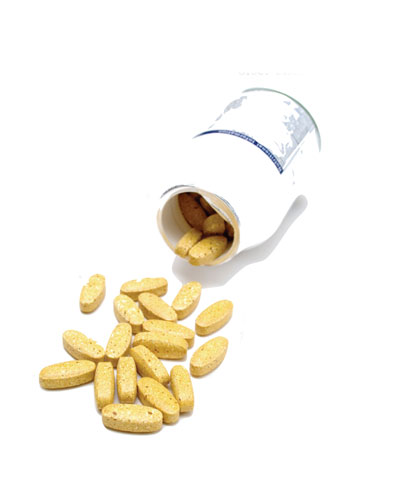
Researchers from
After controlling for a number of factors, participants with the highest quartile of energy-adjusted glycemic index had an increased risk of early AMD (risk ratio: 1.69; 95 percent confidence interval: 1.05-2.72) or indistinct soft or reticular drusen (RR: 1.65; CI: 1.01-2.8). Participants consuming the highest quartile of breads and cereals (predominantly low-glycaemic index foods like oatmeal and wholemeal/grain breads) had a lower risk of early AMD. Glycemic index wasn't associated with late AMD, and when researchers excluded patients with diabetes, the results weren't altered.1148
Researchers from Harvard and the National Eye Institute say a randomized, double-blind, controlled trial shows that daily supplementation with folic acid, vitamin B6 and vitamin B12 may be protective against AMD in women.
The subjects were part of the larger Women's Antioxidant and Folic Acid Cardiovascular Study, and numbered 5,205. They were randomized to folic acid (2.5 mg/d), vitamin B6 (50 mg/d) and vitamin B12 (1 mg/d) or placebo.
During an average of 7.3 years, there were 137 cases of AMD, including 69 that caused vision loss to 20/30 or worse. There were 55 cases of confirmed AMD in the supplementation group compared to 82 in the placebo group (RR: 0.66; CI: 0.47-0.93; p=0.02). For AMD with vision loss, there were 26 cases in the supplementation group and 43 in the placebo (RR: 0.6; CI: 0.37-0.98; p=0.04).1152
Researchers from the Pan-American Collaborative Retina Study Group (PACORES) will report on their results with bevacizumab for choroidal neovascularization not associated with AMD.
The doctors retrospectively evaluated the records of patients from eight centers in seven different countries who were treated with one or more injections of 1.25 or 2.5 mg of bevacizumab. There were 69 eyes of 69 patients total. The etiologies of the CNV included:
• myopia (27 eyes);
• idiopathic CNV (16 eyes);
• angioid streaks (10 eyes);
• inflammatory CNV (4 eyes);
• central serous choroidopathy
(4 eyes);
• parafoveal telangiectasias
(3 eyes);
• serpiginous choroidopathy
(2 eyes); and
• other (3 eyes).
The researchers administered retreatment if leakage and/or fluid was present during the follow-up period, which ranged from eight to 60 weeks (average: 24).
The patients' average visual acuity went from a mean of 20/250 (range: 20/40 to 20/1250) to 20/100 (range: 20/20 to 20/1000). Sixty-nine percent of eyes improved by two or more lines, 29 percent were stable and 3 percent had decreased acuity. The mean central foveal thickness on optical coherence tomography went from 374 µm to 270. The etiologies with the most eyes showing improvement were myopia (78 percent) and idiopathic CNV (62 percent). Complications included subconjunctival hemorrhage in two eyes, ocular hypertension in two eyes and bacterial endophthalmitis in one.4935
A group of researchers from the
Patients who were positive for intraocular lymphoma were treated with 400µg/0.1 ml of methotrexate intravitreally twice a week for a month, once weekly for two months and then once a month for nine months for a total of 25 injections.
Over a 10-year period, the physicians treated 45 eyes of 26 patients, and all of them had a complete response after an average of six injections. None of them have had an intraocular recurrence. The most common side effects were hyperemia and corneal epitheliopathy, which subsided as the injections were spaced farther apart.3989
Dr. Regillo is professor of ophthalmology at











